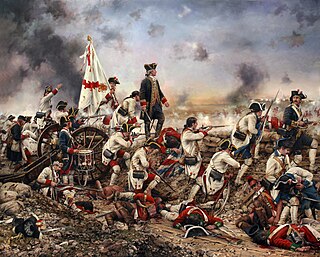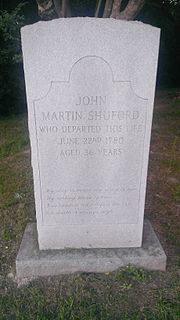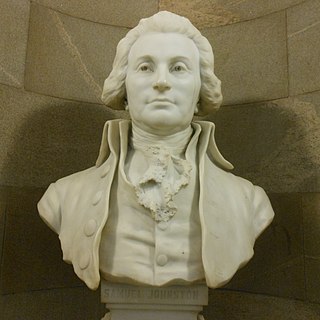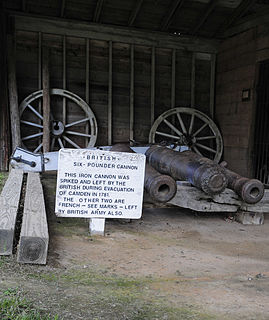 W
WSpain played an important role in the independence of the United States, as part of its conflict with Britain. Spain declared war on Britain as an ally of France, itself an ally of the American colonies. Most notably, Spanish forces attacked British positions in the south and captured West Florida from Britain in the Siege of Pensacola. This secured the southern route for supplies and closed off the possibility of any British offensive through the western frontier of United States via the Mississippi River. Spain also provided money, supplies and munitions to the American forces.
 W
WThe Battle of Camden was a major victory for the British in the Southern theater of the American Revolutionary War. On August 16, 1780, British forces under Lieutenant General Charles, Lord Cornwallis routed the numerically superior U.S. forces led by Major General Horatio Gates about four miles north of Camden, South Carolina, thus strengthening the British hold on the Carolinas following the capture of Charleston.
 W
WThe Battle of Fishing Creek, also called the Battle of Catawba Ford, was an American Revolutionary War battle fought on August 18, 1780, between American and British forces including the 71st Foot. It was fought near the junction of Fishing Creek and the Catawba River in South Carolina. British forces under Banastre Tarleton surprised the militia company of Thomas Sumter, killing a significant number, taking about 300 captives, and very nearly capturing Sumter, who some say was asleep at the time of the attack.
 W
WThe Battle of Kings Mountain was a military engagement between Patriot and Loyalist militias in South Carolina during the Southern Campaign of the American Revolutionary War, resulting in a decisive victory for the Patriots. The battle took place on October 7, 1780, 9 miles (14 km) south of the present-day town of Kings Mountain, North Carolina. In what is now rural Cherokee County, South Carolina, the Patriot militia defeated the Loyalist militia commanded by British Major Patrick Ferguson of the 71st Foot. The battle has been described as "the war’s largest all-American fight".
 W
WThe Battle of Musgrove Mill, August 19, 1780, occurred near a ford of the Enoree River, near the present-day border between Spartanburg, Laurens and Union Counties in South Carolina. During the course of the battle, 200 Patriot militiamen defeated a combined force of approximately 300 Loyalist militiamen and 200 provincial regulars.
 W
WThe Battle of Ramsour's Mill took place on June 20, 1780 in present-day Lincolnton, North Carolina, during the British campaign to gain control of the southern colonies in the American Revolutionary War. The number of fighters on each side of the battle is still an issue of contention, but Loyalist militiamen outnumbered Patriot militia and had captured a group of Patriots who they were planning to hang on the morning of June 20.
 W
WThe Battle of Springfield was fought during the American Revolutionary War on June 23, 1780, in Essex County, New Jersey. After the Battle of Connecticut Farms, on June 7, 1780, had foiled Lieutenant General Wilhelm, Baron von Knyphausen’s expedition to attack General George Washington’s army at Morristown, New Jersey, Knyphausen and Lieutenant General Sir Henry Clinton, British commander-in-chief in North America, decided upon a second attempt. Although the British were initially able to advance, they were ultimately forced to withdraw in the face of newly arriving rebel forces, resulting in a Continental victory. The battle effectively ended British ambitions in New Jersey.
 W
WThe Battle of St. Louis, also known as the Battle of Fort San Carlos, was an unsuccessful attack led by the British on St. Louis on May 26, 1780, during the American Revolutionary War. A former British militia commander led a force primarily of Indians and attacked the settlement. Fernando de Leyba, the Lieutenant Governor of Spanish Louisiana, led the local militia to fortify the town as best as they could and successfully withstood the attack.
 W
WThe Battle of Bull's Ferry on 20 and 21 July 1780 saw two American brigades under Brigadier General Anthony Wayne attack a party of Loyalist Americans led by Thomas Ward. The Loyalists successfully defended a blockhouse against an ineffective bombardment by four American artillery pieces and a failed attempt to storm the position by Wayne's infantry. During the action, American light dragoons under Major Light Horse Harry Lee drove off a large number of cattle that were kept in the area for the use of the British army in New York City. The clash inspired British Major John André to write a satirical ballad entitled The Cow Chace. The skirmish was fought at Bulls Ferry, New Jersey in the Northern theater of the American Revolutionary War after Saratoga. At this stage of the conflict only raids and minor actions occurred in the north.
 W
WThe Constitution of the Commonwealth of Massachusetts is the fundamental governing document of the Commonwealth of Massachusetts, one of the 50 individual state governments that make up the United States of America. As a member of the Massachusetts Constitutional Convention of 1779, John Adams was the document's principal author. Voters approved the document on June 15, 1780. It became effective on October 25, 1780, and remains the oldest functioning written constitution in continuous effect in the world. It was also the first constitution anywhere to be created by a convention called for that purpose rather than by a legislative body. Only the Constitution of San Marino has sections still in force that are older.
 W
WExpédition Particulière was the code name given by the French government for the plan to sail French land forces to North America to support the American rebel forces against Britain in the American Revolutionary War. In English it was known as the Special Expedition.
 W
WThe Fayetteville Convention was a meeting by 271 delegates from North Carolina to ratify the US Constitution. Governor Samuel Johnston presided over the convention, which met in Fayetteville, North Carolina, from November 16 to 23, 1789 to debate on and decide on the ratification of the Constitution, which had recommended to the states by the Philadelphia Convention during the summer of 1787. The delegates ratified the Constitution by a vote of 194 to 77, thus making North Carolina the 12th state to ratify the constitution.
 W
WThe Great Hurricane of 1780, also known as Huracán San Calixto, the Great Hurricane of the Antilles, and the 1780 Disaster, is the deadliest Atlantic hurricane on record. An estimated 22,000 people died throughout the Lesser Antilles when the storm passed through them from October 10–16. Specifics on the hurricane's track and strength are unknown because the official Atlantic hurricane database only goes back to 1851.
 W
WThe Haldimand Affair was a series of negotiations conducted in the early 1780s between Frederick Haldimand, the British governor of the Province of Quebec, his agents, and several people representing the independent Vermont Republic.
 W
WHistoric Camden Revolutionary War Site is a national historic district and open-air museum located in Camden, Kershaw County, South Carolina, United States. Roughly 40 minutes away from Columbia, the state capitol, it is one of the state's largest tourist attractions. The 107-acre site is also known as Historic Camden Revolutionary War Restoration, and as the British Revolutionary War Fortifications. Camden contains preserved structures and grounds that are representative of the Southern theater of the American Revolutionary War. The site is managed by a consortium of private donors and local governments. The area is also an affiliated unit of the National Park Service.
 W
WThe Hobart Gap is a pass and road through the Watchung Mountains in Northern New Jersey. During the American Revolutionary War, Hessian General Baron Wilhelm von Knyphausen attempted to seize the Hobart Gap, now crossed by present-day Route 24, in order to attack the American headquarters in Morristown for the British. He was met with successful resistance by General Nathanael Greene, and was eventually defeated by the Continental Army and the New Jersey Militia at the Battle of Springfield.
 W
WThe New World of the Western Hemisphere was devastated by the 1775–1782 North American smallpox epidemic. Columbus' first voyage to America can be attributed for bringing the smallpox virus to America and led to its spread across most of the continent of North America.
 W
WThe Battle of Piqua, was a military engagement fought on Aug. 8, 1780 at the Indian village of Piqua along the Mad River in western Ohio Country between the Kentucky militia under Gen. George Rogers Clark and Shawnee Indians under Chief Black Hoof. The Indians were driven off and the village and surrounding fields burned, but Clark suffered daunting casualties.
 W
WThe Battle of Waxhaws took place during the American Revolutionary War on May 29, 1780, near Lancaster, South Carolina, between a Continental Army force led by Abraham Buford and a mainly Loyalist force led by British officer Banastre Tarleton. Buford refused an initial demand to surrender, but when his men were attacked by Tarleton's cavalry, many threw down their arms to surrender. Buford apparently attempted to surrender. However, the British commanding officer Tarleton was shot at during the truce, causing his horse to fall and trap him. Loyalists and British troops were outraged at the breaking of the truce in this manner and proceeded to fall on the patriots.
 W
WThe Westervelt massacre, also known as the Westerfield massacre, was an indigenous attack on a caravan of Dutch frontier settlers that occurred during the American Revolutionary War around 3:00 am on June 27, 1780 in Kentucky County, Virginia, the present day state of Kentucky. It remains one of the largest massacres in Kentucky state history, and its modern location is near Brooks, in north-central Bullitt County, Kentucky. The settlers were traveling southeast from Low Dutch Station to Harrod's Town. The caravan's route took them south via what would become Old Shepherdsville Road all the way to present Shepherdsville, before turning east-southeast down the trails along the Salt Fork River, taking them through modern Spencer County all the way to Harrodsburg. But they never even made it to Shepherdsville. The settler relocation was in part a reaction to British Captain Henry Bird's invasion of Kentucky. The area immediately east of Low Dutch Station had been overrun with British allied Indians. Harrod's Town was fortified and a move south would lead the settlers away from Captain Bird's invading army from the north. The caravan was ambushed in a surprise attack, during the night, after a day's travel of twelve miles. The exact location of the massacre is not definitively known. However, it is likely to have occurred at Floyd's Fork and Broad Run. The Westervelt caravan was formed by Jacobus Westervelt and consisted of forty-one settlers from ten different families. Ten of the seventeen settlers killed were members of the Westervelt family. The victims included men, women, and children. The Indians responsible for the massacre were allied to the British and received £5 for each victim's scalp cut off and returned to the British authorities. The Indians were thus awarded £85 by the British for massacring the Dutch settlers. The Westervelt Massacre had a chilling effect on the region. A number of settlers from Low Dutch Station joined Colonel George Rogers Clark's militia after the massacre.